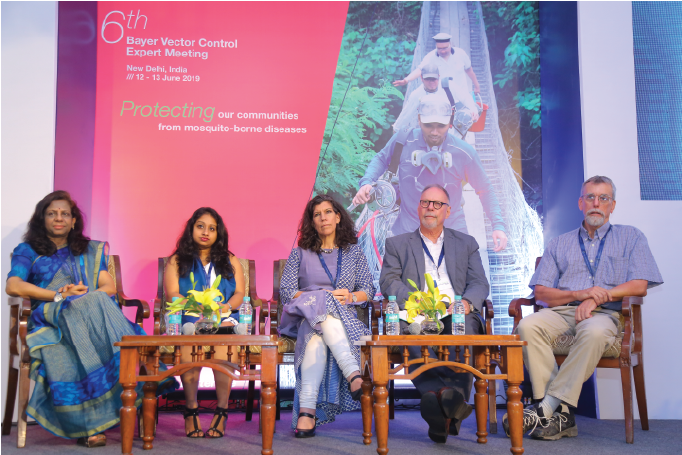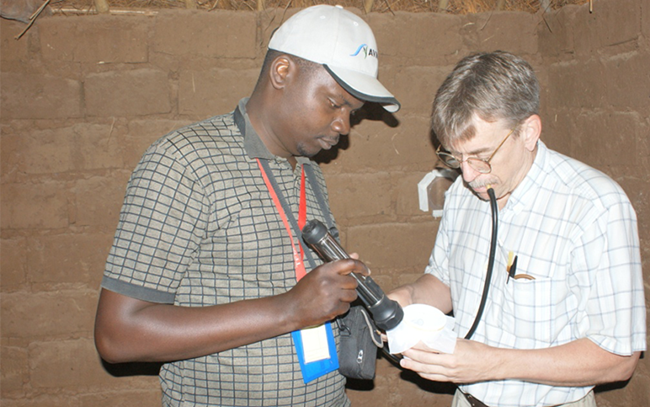Interview with Dr Michael Bangs - Director of Public Health and Malaria Control Services, International SOS, Papua, Indonesia
Do you have what it takes to protect communities against deadly mosquito-borne diseases? We speak with Dr Michael Bangs, a renowned vector control specialist to find out more about the important work that he is doing towards eliminating malaria in the region and the role private corporations can play in disease elimination.
Please share with us a bit of your background and what made you decide to be a vector control specialist?
My entry into the world of vector control began in the 1970s in Sabah, Malaysia (northern Borneo) working with the State malaria control program. While in remote Borneo, I had firsthand exposure to what organized ‘operational’ vector control entailed. Subsequently, a stint at the University of California, Los Angeles resulted in Masters degrees in medical entomology and another in public health - infectious disease epidemiology. Following that, I spent nearly 21 years in the US Navy as a public health entomologist assigned as a Preventive Medicine Officer working almost entirely overseas in multiple and diverse locations, the bulk of that time in Southeast Asia (primarily Indonesia). I was fortunate enough to balance multi-disciplinary, academic driven Research & Development assignments with operational control exercises using the most up-to-date technologies available – a unique mix of experiences that have served me well throughout many duties. During my Navy years, I was privileged to be sponsored to obtain a PhD in medical entomology, work that exposed me to Central America. Following my ‘retirement’ from military service (2006), I joined a private medical assistance company, International SOS, as Director of Vector-borne Disease Control Programs. The job has taken me across the globe with most of the activities focused in the Asia-Pacific region and Africa. This multi-faceted job involves everything from conducting vector-borne disease risk assessments (predominately malaria and Aedes-borne diseases), assessing current vector and pest control programs, to the design and implementation of large integrated vector and disease control programs, primarily for the extractive industry (mining and energy). Currently, I live and work in Papua, Indonesia.
Why a life as a vector control specialist? Interesting question. Frankly, I feel it was never a “decision” on my part to become a vector control specialist – a series of events involving luck, serendipity and happenstance thrust itself upon me to pursue this very interesting career path and I have never looked back. I could not think of another job more suited to my general interests in applied biology, research, teaching, operational control and travel.
Dr Bangs (right) conducting a wall bioassay to test the efficacy and residual activity of an indoor residual spray used for malaria control.
You are currently conducting research on spatial repellents to control malaria transmission in western Sumba, Indonesia. Can you tell us more about it and if there is any outcome so far that could help other countries manage this disease?
It would be best to start with defining spatial repellency (SR). It has been nearly 75 years since the role of spatial repellency (deterrence or avoidance action by mosquitoes) was first described as a potentially beneficial attribute in malaria control, whereby showing chemicals could effectively disrupt normal mosquito behavior and interrupt contact with humans, thus preventing disease transmission without actually killing the insect. SR refers to a range of insect behavioral responses induced by airborne chemicals that ultimately result in a reduction in human-vector contact. This can include movement away from a chemical stimulus, the interference with host detection (attraction-inhibition cues), and/or feeding response. In short, repellent actions drive mosquitoes away from a treated space, thus providing a ‘safe zone’ free of transmission. Repellency can also occur after physical contact with a chemical, a response called ‘excitation’ (also termed contact ‘irritancy’) producing a specific locomotor action disrupting normal adult behavior (resting, host seeking, for example). Currently, the majority of commercial spatial repellent products are either low concentrations of short-duration synthetic pyrethroids (e.g., pyrethrins, allethrin, metofluthrin, transfluthrin) or botanical-based compounds (e.g., essential oils).
The World Health Organization (WHO) Vector Control Advisory Group (VCAG) reviews epidemiological and entomological evidence on new vector control intervention ‘classes’, to endorse, or not, public health value of vector control tools and setting policy recommendations. Spatial repellents is one of these classes undergoing detailed assessments in the laboratory, semi-field (experimental) designs, and full field-based intervention trials.
Following the initial findings of an earlier study conducted in Sumba, Indonesia using commercial mosquito coils inside houses, a much larger, randomized cluster, double-blinded, placebo-controlled trial (RCT) was conducted to measure the efficacy of a spatial repellent for household occupants at risk of malaria. The primary endpoint was epidemiological – the prevention of malaria infection, while the entomological correlates (e.g., blood feeding density) were secondary measures of interest. With this epidemiological primary endpoint in mind, the most recent, large-scale study aimed to build upon previous findings and provide rigorous evidence of a spatial repellent producing sufficient protective efficacy against malaria infection risk by decreasing the mean anopheline human-landing (biting) exposure in malaria-endemic communities. While the study findings indicated the spatial repellent provided a protective effect, additional evidence will be required for a determination of a WHO-VCAG recommendation for spatial repellents as a useful malaria control intervention. The very recently completed trial has generated valuable data that can contribute to the assessment and further development of SR products. A very similar trial looking at Aedes response is near completion. These results have encouraged substantial investment to validate the efficacy of ‘next-generation’ products through larger RCTs, including an investigation of possible diversionary effects of spatial repellency on human health (i.e., potential increased risk of malaria incidence in households near SR intervention not receiving product), and evaluation of the optimal delivery systems for humanitarian assistance use-case scenarios.
Spatial repellency tools are undergoing development by the private industry in collaboration with academic institutions. With each study, SR is gaining traction as a potential control method, either alone, or more likely as complementary with existing control tools. To meet malaria elimination targets, there is an urgent need for innovative methods to tackle both indoor and outdoor transmission. Spatial repellents is a promising avenue to achieve better vector control in more difficult transmission settings.
According to the 2018 World Malaria Report by the World Health Organization (WHO), although Malaria incidences and deaths have reduced, there has not been considerable progress for some endemic countries towards eliminating the disease. What are your thoughts about this?
The capacity and capability gaps in some of the most malaria-endemic countries in the world are large (no, ‘huge’), most notably in impoverished areas of sub-Saharan Africa. Currently, without the significant ‘external’ support provided by bi- and multi-lateral donors, many of these countries would likely have no means of implementing and maintaining meaningful control programs except in the most rudimentary forms of response (i.e., diagnosis and treatment). Vector control in many countries is lacking completely, while insecticide-treated bed netting (also typically dependent upon donor support) represents the only form of transmission control available. This is simply not enough to combat malaria effectively or sustainably in many endemic areas. The current observations that malaria incidence reduction, rapid at first, has now dramatically slowed in pace or even reversed in some locations, should come as no great surprise. It is a testament of the resilience of the malaria parasite to adapt and survive. While malaria most amendable to control has been successfully pushed back using a variety of integrated tools, what remains are the more difficult situations, the result of a multitude of circumstances that contribute to so-called refractory malaria. One area of greater interest today is the impact of outdoor (so-called ‘residual’) transmission that continues to confound control efforts. Compounding factors like poor infrastructure, poverty, civil disruption, and erratic population mobility also play a profound role in maintaining and exacerbating malaria transmission. Simply put, no matter the number tools that exist to tackle malaria head-on, the control or elimination of this disease in many areas will remain a great hurdle to come.
In your experience, what initiatives have been working well in Papua that other countries like India and Vietnam can replicate when it comes to controlling the Anopheles mosquito?
Unfortunately, there is very limited vector control occurring in Papua, Indonesia as a whole. The current malaria control program in Papua relies almost exclusively on passive diagnosis and treatment at primary health care facilities and the periodic mass distribution of insecticide-treated bed nets. The result is plain to see – no place outside of sub-Saharan Africa has a greater malaria burden than Papua – no place. The only locations where integrated vector control does occur are heavily sponsored by the private industry (mining and energy), and relatively speaking, small in scope given the vast geography of Papua (western half of the island of New Guinea). Moreover, these ‘private’ program initiatives have only rudimentary public partnerships of support. Private sponsored programs systematically incorporate appropriate (to location) methods for attacking both adult (e.g., indoor residual spray) and immature vector species (larval source management techniques). Furthermore, the design of these organized programs use evidenced-based principles, and combined with long-term commitments, have resulted in substantial reductions in malaria risk. Unlike Papua, both India and Vietnam, as examples, have committed themselves to public-sponsored control programs that also integrate vector control components. The contrasts between Papua and most countries in Asia could not be starker. However, what Papua and other locations with private-sponsored control programs have shown clearly is that effective malaria control is possible provided the necessary resources and proper organization are in place. Malaria is surmountable if control is carefully conceived and tailored to fit the local conditions. For those countries advancing towards malaria elimination, those goals and timelines can be facilitated if linked with the private industry to form true public-private partnerships to promote malaria control in their respective communities. Most private industries have the means and willingness to contribute; they sometimes just need to be shown the direction.
What do you think private corporations can do more to support the vector control community in Asia-Pacific?
This is somewhat tied with the previous question and my response regarding private business entities and their ability and willingness to assist health programs in general. This goes beyond the protection of their own employees but can often expand to community outreach programs to control malaria and other vector-borne diseases. Sadly, however, these types of public-private links are far below their potential for forming viable partnerships in the region. Either by direct contributions in the form of funds and other resources or actual participation in active control programming should be encourage, even incorporated into the terms of business contracts obligating companies to support local communities with a set low percentage contribution of annual net profit. Private companies are uniquely positioned where vector-borne diseases are prevalent and have a direct impact on the productivity of their workforce and the welfare of the surrounding communities. These companies can also offer much more than just resources, such as systems for maintaining critical logistical chains, strong networking that establish long-term local, national and international relationships, and data exchange supporting real-time outbreak reporting and response mechanisms, for instance. Private corporations can also provide capability training and capacity building of institutions, and a ‘nationalization’ of programs towards a sustainable future. For example, this has also resulted in support for training in vector control skills for control programs, public entities, as well as communities. In fact, these trained resources might represent the very few in an area, even an entire country, with adequate vector control skill sets. To not take advantage of what private industries can potentially contribute, especially in remote locations, is to disregard unique opportunities for meeting collective goals and mutual long-term, productive collaborations. Examples are aplenty – these include industry-sponsored integrated health programs serving as a ‘foundation’ for expanding other health initiatives (TB and HIV, for example);established health platforms that serve as local/regional ‘Centers of Excellence’, and the creation of regional ‘Hub & Spoke’ cooperative programming and network base. Private industries can be a focal point for creating partnerships for standardized regional surveillance, information and data exchange with the ability to complement local and regional resources to expand the base of cooperative operations.
With increasing regulatory environment and chemophobia, should chemical interventions still be an important part of vector control programs? If yes, how can we communicate that this is necessary?
Absolutely! Every possible invention ‘tool’ should be available and optimally applied to combat vectors. Generally, no single intervention strategy will suffice to reduce transmission to manageable levels. Complementary means of control are best to attack different life stages of vector populations. Chemicals can be reserved as a ‘last’ option, because of cost or other reasons, in lieu of other tools (e.g., larval source management, housing improvement). The use of chemicals, whether for treatment of bed nets or direct control of adult and immature stages of mosquitoes (e.g., residual applications to surfaces or as space sprays), will continue to play an essential role in vector control. Lastly, chemical intervention is an essential response for tackling vector-borne disease outbreaks in wide scale - few, if any, other methods will suffice to quickly knock back transmission.
Regarding the general public perception of chemical use, this can be broadly divided into 2 groups: those in the more developed world that lack (or experience very low incidence) vector-borne diseases, and those living in less developed regions where diseases such as malaria and dengue inflict an untold burden on the population. As expected, these two groups can have opposing views on the use of chemicals. I have yet to encounter frank or overwhelming opposition to the use of chemicals in the latter. For those with a reflexive aversion and vocal rejection for chemical use require carefully crafted education (‘enlightenment’) as to the merits and importance of chemicals in matters of public health concern. For those people who are more recalcitrant in view, repetition and patience is advisable to get the message across. When no other viable or affordable control alternatives exist, the notion of allowing people to suffer from preventable diseases because of inflated concerns of the harmful effects of chemicals used to control vectors is unconscionable in my view. It simply begs a serious ethical dilemma for those advocating withholding life-saving solutions to those in need. In many cases, it simply comes down to laying out the alternatives and options available when measured against the consequences of inaction or inferior practice. Once informed, most rational people will come to a sound conclusion that despite the possible risk an unwanted chemical exposure might pose beyond the expressed objective (i.e., vector control), so long as the chemical is used appropriately, its potential direct impact on the environment and human health pales in comparison to the devastating consequences of a disease like malaria.
Last but not least, do you foresee any disturbing trends in the future for vector control and can anything be done to minimize the impact?
In the past several decades, there has been a revival in the understanding and recognition (dare I say, ‘appreciation’) that vector control is both very useful and a viable operational means for controlling many vector-borne diseases. However, what has lagged has been the development of a larger cadre of professional public health entomologists to help direct these control efforts in the field. Although academic and research-oriented entomology has also suffered to some relative degree, the applied operational side of the equation has struggled the most to regain the traction lost decades ago.
In particular, malaria vector control has had a very rich history going back to the very beginning of the last century. For vector control to succeed and be operationally relevant, there is no more critical an issue to overcome than the lack of sufficient support for entomological training and providing viable career opportunities and path progression in the field. This is not a new concern – in fact, an issue that has been discussed and lamented openly for at least 50 years, especially since the end of the malaria eradication campaigns of the 1950s and 60s. How this long-term trend can be reversed remains an open question with multiple solutions. The dearth of entomological expertise in public health is a chronic problem, one greatly influenced by the erosion of formal training centers (academic and applied) available today. I believe a reawakening of public health entomology is primarily dependent on a greater understanding and commitment within countries and influential donors to the value of vector control as an essential tool in the fight against vector-borne disease. As discussed previously, input from private industries, maybe most notably, chemical companies are best placed to expound upon the merits of vector control and assist those who would choose it as a long-term career.

------
 |
About Dr Bangs Dr Michael Bangs is currently the Director of Public Health and Malaria Control Services at International SOS based in Papua, Indonesia. He is actively engaged in numerous private sector public health and malaria control programs in Asia and Africa. He has also worked in Indonesia for over 30 years focusing on public health initiatives and conducting research related to vector-borne disease control. An entomologist by training, Dr Bangs has authored over 250 research articles on vector control, insecticide resistance and vector-borne disease epidemiology. |

